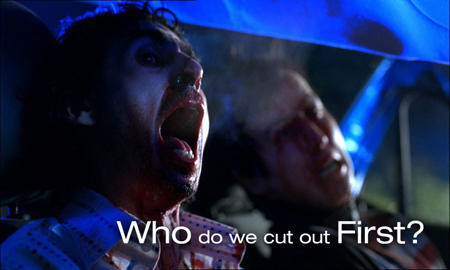Safety messages |
| David Lyle and Julie Anne Bailie explain the rationale behind the awarding-winning road safety campaigns |
Research shows that the road safety TV ads are one of the top three most influential factors in reducing road carnage, alongside Garda enforcement and new road traffic laws. Advertising never works on its own but is designed to work in combination with enforcement to change attitudes and behaviour.
In tracking research, 82 per cent of adults rate the RSA's road safety TV ads as an influential factor in saving lives. There are three reasons why the advertising works. Firstly, there is a rigorous evidence-based methodology which is data-led, research-led and psychology-led. Secondly, the use of psychological creativity to emotionally engage people. Emotional engagement is key. Thirdly, the strategic use of shock to encode long-term emotional memory.
People can be used be disturbed by the graphic images used in ads. But if we don't disrupt and disturb, people stay oblivious to the dangers on the roads. The road is the most dangerous place the average person goes daily. But the public supports the use of disturbing images.
In research, most people agree that the use of disturbing images is necessary for road safety. Even people who have lost members of their family as a result of road tragedy, without exception say that while the ads are difficult for them to watch, it is vital that they are screened to prevent other families having to go through what they did.
The road safety ads score highly among young people, achieving some of the best recall and influence scores in the market. Independent qualitative research also confirms that the young people in Ireland are highly engaged by the ads. They need to be confronted with reality. They have to be shocked and for that to happen they are must be drawn in by a narrative which allows them no escape.
Young viewers are among the most highly literate when it comes to advertising and the most cynical. So, you can't afford to get it wrong. They are a testing audience which, when it comes to road safety, will reject any type of abstract symbolism or patronising in favour of what they know to be the truth.
This works its way right through the ads, even to how we wardrobe the cast. Young people notice everything. They have seen every action film and played every video game that counts so the experiences we offer have to match.
 |
Young people know that if they didn't wear their seatbelt in the back seat they can become a multiple killer. If they didn't accept this Ireland would not have quadrupled its back seatbelt wearing rates which has led to the highest ever recorded seatbelt wearing rates, North and South.
Males aged 17-24 are the most over-represented group as victims and drivers responsible for road carnage. But we always have broader secondary target audiences and the primary target can change depending on the problem.
To date, there have been 75 quantitative surveys independently conducted by Millward Brown, plus 624 focus groups. Some 91,367 people have been interviewed in the Republic and 89,173 in Northern Ireland, so we reckon road safety is one of the most researched and tested campaigns in the market.
From the research we have written a portfolio of case studies, winning a total of 26 effectiveness awards from independent juries. Our seatbelts case study won the IAPI ADFX Grand Prix for Effectiveness and a European Effie in Brussels.
Psychology is pivotal when it comes to the development and production of the campaigns. Since 1993, we have been the only advertising agency to have a psychology research unit headed up by a full-time psychology director.
The agency has a psychological testing system which we use in conjunction with other forms of research to test the work before it ever goes on air. Road safety is a highly complex area. There is no simple, quick-fix solution when it comes to identifying the key motivational triggers; many issues run deep.
The superficiality of what people say is not enough. We need to penetrate behind the fa









